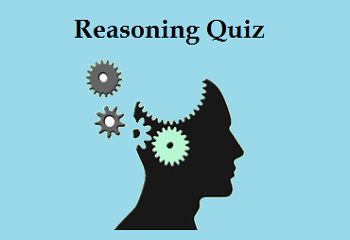Hello Aspirants. Welcome to Online Quantitative Aptitude section in AffairsCloud.com. Here we are creating question sample From all topics , which are Important for upcoming IBPS exams. We have included Some questions that are repeatedly asked in exams.
- A train starts from station A at 6:00 AM and reaches station B at 9:00 AM. Another train starts from station B at 7:00 AM and reaches station A at 11:00 AM. At what time the two trains will meet?
A. 8:00 AM
B. 8:08 AM
C. 8:48 AM
D. 9:08 AMA. 8:00 AM
Explanation:
Let the distance from A to B is ‘d’ km.
First train reaches destination in 3 hrs, so speed of first train = d/3 km/hr.
Speed of second train = d/4 km/hr
Speed of first train = d/3 km/hr, so after 1 hr, i.e. at 7:AM, the first train has covered d/3 km.
The distance left = (d – d/3) km = 2d/3 km. relative speed = d/3 + d/4.
So time they will meet at = 7:00 AM + (2d/3) / (d/3 + d/4)
= 7:00 AM + 1 (1/7)*60 = 8:08 AM - A man starts at 8:00 AM with speed 25 km/hr. Another man 300 km away from first man starts at 9:00 AM at 30 km/hr in opposite direction of the first one. At what time will they meet?
A. 11: 00 AM
B. 2:00 PM
C. 1:00 PM
D. 3:30 PMB. 2:00 PM
Explanation:
Distance is 300 km
Speed of first = 25 km/hr, so after 1 hr, i.e. at 9:00 AM, the first has covered 25 km.
The distance left = (300 – 25) km = 275 km. relative speed = 25 + 30 = 55
So time they will meet at = 9:00 AM + 275 / 55
= 9:00 AM + 5 hrs = 2:00 PM - A vessel is full of milk. 6 litres are drawn from vessel and filled with water. This operation is performed two more times. The ratio of the quantities of milk and water in vessel is 8 : 117. How much milk did the vessel contain originally?
A. 15 litres
B. 10 litres
C. 20 litres
D. 30 litresB. 10 litres
Explanation:
When the original quantity is x litres, and y litres of mixture is poured out and again filled with water with operation being performed n times.
The quantity left is = x [1 – y/x]n
Here the final ratio is 8 : 117
So,
8/8+117 = x [1 – 6/x]3 / x
8/125 = [1 – 6/x]3
2/5 = [1 – 6/x]
X = 10 - A motorboat whose speed is 15 km/hr in still water goes 30 km upstream and back again to the starting point in 4 hours 03 minutes. Find the speed (km/hr) of the stream.
A) 3
B) 5
C) 5/3
D) 10C) 5/3
Explanation:
4 hrs 03 min = 4 3/60 = 4 1/20 = 81/20Distance = time * [B^2 – R^2] / 2*B
30 = 81/20 * [15^2 – R^2] / 2*15 - A man travel a distance of 80 km in 7 hrs. Some part he travels by foot and some by car. If speed with foot is 8 km/hr and with car is 14 km/hr, how much distance is travelled by car?
A. 12 km
B. 24 km
C. 56 km
D. 60 kmC. 56 km
Explanation:
By allegation method
8 14
. 80/7
14 – 80/7 = 18/7 80/7 – 8 = 24/7
Ratio of times = 18/7 : 24/7 = 3 : 4
So out of 7 hrs, 3 hrs by foot, and 4 hrs by car
Distance by car = 14*4 = 56 km - A and B jointly invest Rs. 2100 and Rs. 3100 respectively in a firm. A is an active partner and he gets 25% of the profit separately. If their business yields them total Rs. 1040 as profit, what will be the gain of each of them?
A) Rs. 415, Rs. 625
B) Rs. 575, Rs. 465
C) Rs. 515, Rs. 425
D) Rs. 465, Rs. 575B) Rs. 575, Rs. 465 - A, B, and C invested some money in ratio 3 : 4 : 5. After some time, they receive a profit which is divided among them in ratio 4 : 5 : 6. Find the ratio of the time of their respective investments.
A. 80 : 72 : 75
B. 80 : 75 : 72
C. 75 : 72 : 80
D. 72 : 80 : 75B. 80 : 75 : 72
Explanation:
Let their times are a months, b months, c months respectively.
Investment ratio is 3 : 4 : 5. Then the ratio of profits should be 3*a : 4*b : 5*c
And this ratio is given to be 4 : 5 : 6. So 3a : 4b : 5c = 4 : 5 : 6
So 3a = 4, 4b = 5, 5c = 6
a = 4/3, b = 5/4 , c = 6/5
a : b : c = 4/3 : 5/4 : 6/5 = 80 : 75 : 72 - A shopkeeper sells an item at 20% profit but uses a weight of 1200 gm instead of 1 kg. Find hid net profit/loss %.
A. 15%
B. 12.5%
C. 10%
D. 0%D. 0%
Explanation:
Uses 1200 gm in place of 1 kg.
So loss in this = (1200-1000)/1200 * 100 = 50/3%
Now profit of 20% and successive loss of 50/3%.
So overall profit/loss = 20 – 50/3 + (20)(-50/3)/100 = 20 – 50/3 – 10/3 = 0% - x2 = 1369; y = √1369
A. x ≤ y
B. x ≥ y
C. x > y
D. No relationshipA. x ≤ y
Explanation:
x2 = 1369
x = 37, -37
y = √1369
y = 37
put on number line
-37 37
When y = 37, y ≥ x
So y ≥ x - A man went to market and purchased an item of Rs 15,000 and sold it at a loss of 10%, from that amount he purchased another amount and sold it at a profit of 16%. What is the amount of overall profit made by him in all dealing?
A. Rs 720
B. Rs 660
C. Rs 650
D. Rs 610B. Rs 660
Explanation:
By successive formula, overall profit % = -10 + 16 + (-10)(16)/100 [ – for loss]
= 6 – 1.6 = 4.4%
So, overall profit = 4.4 *15000/100 = 660
AffairsCloud Recommends Oliveboard Mock Test
AffairsCloud Ebook - Support Us to Grow
Govt Jobs by Category
Bank Jobs Notification



